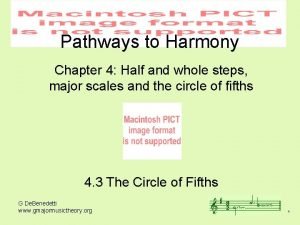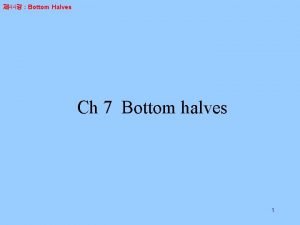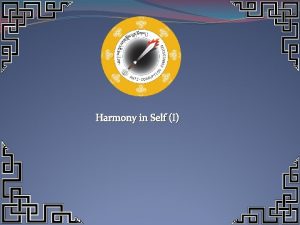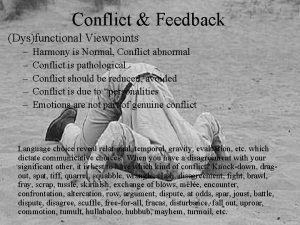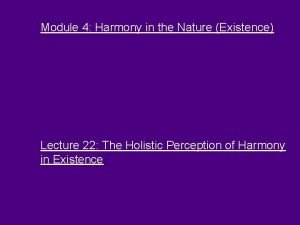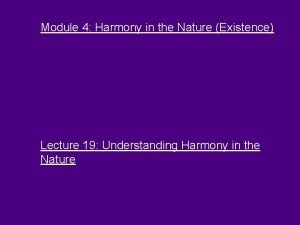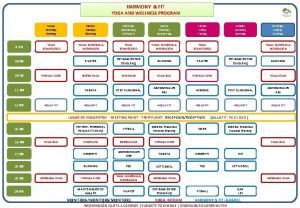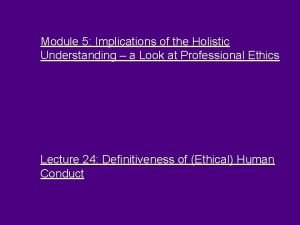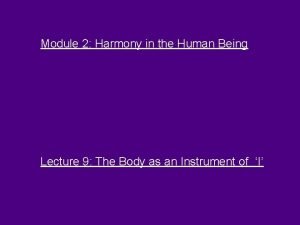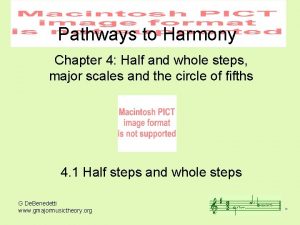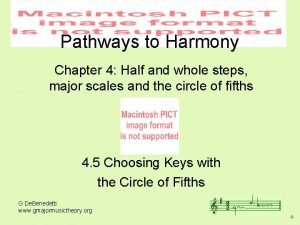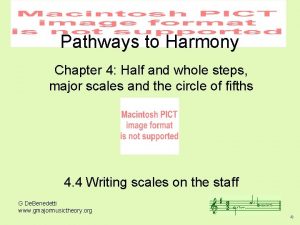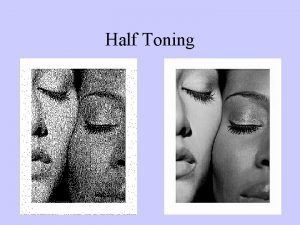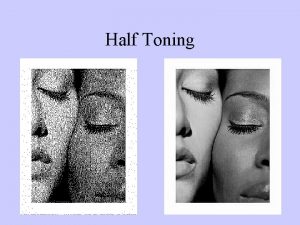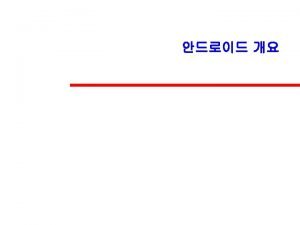Pathways to Harmony Chapter 4 Half and whole





































- Slides: 37

Pathways to Harmony Chapter 4: Half and whole steps, major scales and the circle of fifths 4. 3 The Circle of Fifths G De. Benedetti www. gmajormusictheory. org

• Each note of a scale is identified by a number called a scale degree.

• Each note of a scale is identified by a number called a scale degree. • Scale degree 1 is also called the key note.

• If scales are written clockwise on a circular keyboard and if the key note of each scale is scale degree 5 of the previous scale, then the key notes follow an order called the circle of fifths.

• If scales are written clockwise on a circular keyboard and if the key note of each scale is scale degree 5 of the previous scale, then the key notes follow an order called the circle of fifths. • You will understand better by working along with this presentation

Let's work together… • DOWNDLOAD Chapter Four OR Expanded Chapter Four of Pathways to Harmony from this website http: //www. gmajormusictheory. org/Fundamentals/workbooks. html • PRINT worksheet 4. 5 from Chapter Four OR worksheet 4 Ex. 8 from Expanded Chapter Four • WRITE dots and letters as this presentation guides you around the circle of fifths.

• On this circular keyboard lines separate where each scale is written.

• On this circular keyboard lines separate where each scale is written. • After we rotate and zoom in on this keyboard, we can put dots on the notes of a C scale. Turn your page upside-down.

• On this circular keyboard lines separate where each scale is written. • After we rotate and zoom in on this keyboard, we can put dots on the notes of a C scale.

• On this circular keyboard lines separate where each scale is written. • After we rotate and zoom in on this keyboard, we can put dots on the notes of a C scale.

• On this circular keyboard lines separate where each scale is written. • After we rotate and zoom in on this keyboard, we can put dots on the notes of a C scale.

• On this circular keyboard lines separate where each scale is written. • After we rotate and zoom in on this keyboard, we can put dots on the notes of a C scale.

• On this circular keyboard lines separate where each scale is written. • After we rotate and zoom in on this keyboard, we can put dots on the notes of a C scale.

• On this circular keyboard lines separate where each scale is written. • After we rotate and zoom in on this keyboard, we can put dots on the notes of a C scale.

• On this circular keyboard lines separate where each scale is written. • After we rotate and zoom in on this keyboard, we can put dots on the notes of a C scale.

• On this circular keyboard lines separate where each scale is written. • After we rotate and zoom in on this keyboard, we can put dots on the notes of a C scale.

• Notice that if the key note is C, then the major scale pattern 1 2 3 4 5 6 7 8 W W H W W W H results in all white keys.

• Notice that if the key note is C, then the major scale pattern 1 2 3 4 5 6 7 8 W W H W W W H results in all white keys. • If we keep adding scales whose key notes are scale degree 5 of adjacent scales, then some surprising patterns appear…

The key note of the next scale to the left (clockwise)…

The key note of the next scale to the left (clockwise)… is scale degree 5 of the C major scale, or G.

The key note of the next scale to the left (clockwise)… is scale degree 5 of the C major scale, or G. So we put a "G", in the next box.

• Now we put dots on the keyboard for a G scale.

• Now we put dots on the keyboard for a G scale. • Notice that the pattern, W W H W W W H, requires that the next-to-the-last note be a black key.

Continuing in the same way, The key note of the next scale to the left…

Zoom out -----> Continuing in the same way, The key note of the next scale to the left… is scale degree 5 of the G major scale, or D.

Continuing in the same way, The key note of the next scale to the left… is scale degree 5 of the G major scale, or D. So we put a "D" in the next box…

Continuing in the same way, The key note of the next scale to the left… is scale degree 5 of the G major scale, or D. So we put a "D" in the next box… And write a D major scale.

• You can continue writing scales in this way all around the circle.

• You can continue writing scales in this way all around the circle. • Keynotes in this presentation include – B and its enharmonic, C-flat – F-sharp and its enharmonic, G-flat – And C-sharp and its enharmonic D-flat

• You can continue writing scales in this way all around the circle. • Keynotes in this presentation include – B and its enharmonic, C-flat – F-sharp and its enharmonic, G-flat – And C-sharp and its enharmonic D-flat • The scales of these key notes appear on the bottom of the circle and will be given two boxes, one for each letter.

• You can continue writing scales in this way all around the circle. • Keynotes in this presentation include – B and its enharmonic, C-flat – F-sharp and its enharmonic, G-flat – And C-sharp and its enharmonic D-flat • The scales of these key notes appear on the bottom of the circle and will be given two boxes, one for each letter. • Beyond these enharmonic key notes, all black-key key-notes should be named as flats.

• Here are the surprising results which occur once the circle of fifths is completed:

• Here are the surprising results which occur once the circle of fifths is completed: – Incredibly, all 12 different notes on the keyboard will have been used once and only once as key notes,

• Here are the surprising results which occur once the circle of fifths is completed: – Incredibly, all 12 different notes on the keyboard will have been used once and only once as key notes, – The number of black keys in subsequent scales seem to form a pattern

• Here are the surprising results which occur once the circle of fifths is completed: – Incredibly, all 12 different notes on the keyboard will have been used once and only once as key notes, – The number of black keys in subsequent scales seem to form a pattern – the original key note, C, will be the fifth note of the last scale to be entered, F

• Here are the surprising results which occur once the circle of fifths is completed: – Incredibly, all 12 different notes on the keyboard will have been used once and only once as key notes, – The number of black keys in subsequent scales seem to form a pattern – the original key note, C, will be the fifth note of the last scale to be entered, F • In this way you can complete a true circle—the circle of fifths.

Now it's your turn • COMPLETE worksheet 4. 5 from Chapter Four OR worksheet 4 Ex. 8 from Expanded Chapter Four
 Cdc whole school whole community whole child
Cdc whole school whole community whole child Pathways to harmony chapter 1 answers
Pathways to harmony chapter 1 answers Pathways to harmony chapter 1 answers
Pathways to harmony chapter 1 answers Whole part whole practice
Whole part whole practice Major scale whole and half steps
Major scale whole and half steps The beginning is half of the whole
The beginning is half of the whole Joy luck club double face
Joy luck club double face Direct retention in rpd
Direct retention in rpd Infrabulge area
Infrabulge area Mythological creature half man half horse
Mythological creature half man half horse Half man half horse name
Half man half horse name What is a myth
What is a myth How many heads does a hydra have
How many heads does a hydra have Mulciber roman god
Mulciber roman god Bottom halves
Bottom halves Narnia half geit
Narnia half geit Half empty or half full
Half empty or half full Sheila birling
Sheila birling Chapter 7: pathways to entrepreneurial ventures
Chapter 7: pathways to entrepreneurial ventures Ch 7 a closer look energy metabolism pathways
Ch 7 a closer look energy metabolism pathways Chapter 7 a closer look energy metabolism pathways
Chapter 7 a closer look energy metabolism pathways How can we ensure harmony in self (‘i’)
How can we ensure harmony in self (‘i’) Harmony is normal and conflict is abnormal
Harmony is normal and conflict is abnormal Proximity and harmony
Proximity and harmony Holistic perception of harmony at all levels of existence
Holistic perception of harmony at all levels of existence Nine principles of design
Nine principles of design Harmony in the nature and existence
Harmony in the nature and existence Harmony fit
Harmony fit Ward and siegert's pathways model
Ward and siegert's pathways model Dopamine and serotonin pathways
Dopamine and serotonin pathways Direct and indirect motor pathways
Direct and indirect motor pathways Synel 49
Synel 49 Calm personality
Calm personality Harmony is vertical
Harmony is vertical Definitiveness of ethical human conduct
Definitiveness of ethical human conduct I am the seer, doer and enjoyer
I am the seer, doer and enjoyer Harmony metron
Harmony metron Atari harmony
Atari harmony

